by Dagmara Genda // Mar. 21, 2023
This article is part of our feature topic Money.
To dismiss Darren Bader as a prankster would be to wilfully ignore the lens he focuses not only on the art world, but on the world of things and their circulation. Things exist within a tentative hierarchy that can be destroyed or reconfigured at any time. It’s all just a question of trust. Capitalism, one could conclude from Bader’s practice of dizzyingly exchanging and combining (sometimes art) objects, is not so much an indifferent monetisation of objects or life itself, as a flat ontology that tacitly accepts the instability of value as such. This is why art finds its perfect, if not always happy, reflection in money. Art’s wild price fluctuations are not the result of greedy speculation, as much as the colliding instances of the contemporary moment—flashes of collective will resulting in a stock market crash, a viral video, or the inability of Van Gogh’s contemporaries to see him as a uniquely gifted painter. The question that comes to mind when experiencing Bader’s work is: how does one navigate a reality of constantly meandering, disappearing or exploding value?
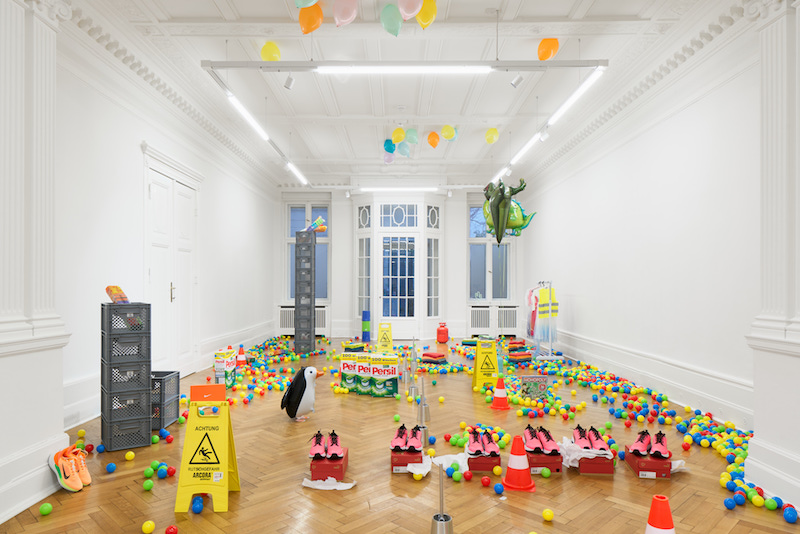
Darren Bader: ‘fünfdreier,’ installation view at Société, Berlin, 2023 // Photo by Joe Clark
Of course, Bader does not have an answer to this question, though he does like to test the limits of how value is produced. He points to the loopholes and contradictions in our assumed system of worth to yield unexpected results, like in his current show ‘fünfdreier’ at Société Berlin. The realisation of the five instruction-based works in the exhibition are in large part dependent on the choices and preferences of the people executing them. For example, the central piece in the show, ‘Amazon.com sculpture,’ is made through the purchasing decisions of its owner. For the price of the artwork, the owner gains the license to buy as little or as much as she wants on the online shopping portal and have her purchase become an artwork. According to the instructions, the owner can make any number of additional sculptures by buying more, but when she does, the old sculpture loses the lustre of Art and dissolves back into the daily hierarchy of things.
The fact that the artwork is updated with each purchase is likely why Bader has not dated this work, and many others like it. His attention to time reflects a parallel interest in meaning—specifically how meaning can coalesce and just as easily evaporate at any given moment.
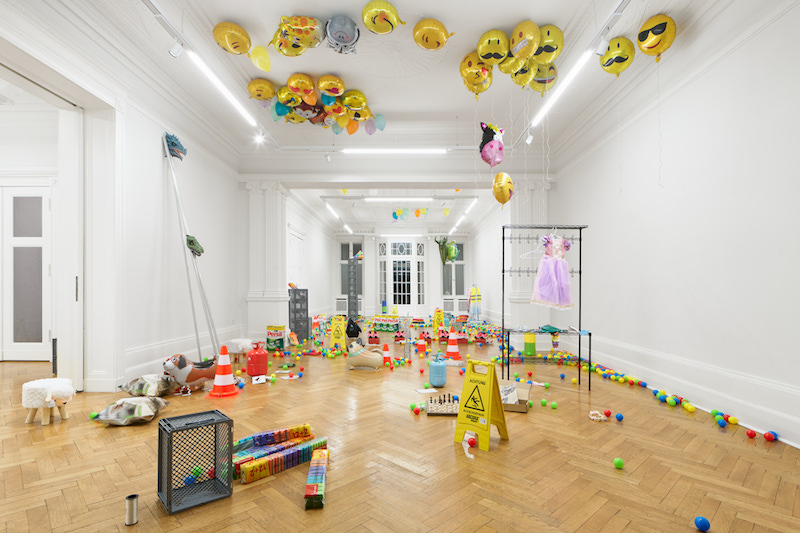
Darren Bader: ‘fünfdreier,’ installation view at Société, Berlin, 2023 // Photo by Joe Clark
Unsurprisingly, Bader has called contemporary art “a tenuous proposition and category,” not least because art has a very particular relationship to value and meaning. In the case of ‘Amazon.com sculpture,’ the value and meaning is both personal (the preferences of its owner) and public (the market value of the art as well as that of the objects as consumer goods), bringing to light the collaborative and oftentimes unconscious balancing act that makes the production of value and meaning possible. Each instruction piece is simultaneously a reflection of its buyer, a work by the artist and an activation of our culture’s problematic consumerism. Bader does indeed spend time pondering what separates art objects from the endless stream of stuff in the world, though this is not the most particularly interesting problem his work addresses, if it can be called a problem at all. History has repeatedly shown that any thing can be an artwork. By incorporating the market and the purchasing decisions of collectors as an integral part of the work, however, Bader hones in on an art object’s endless potential for exchangeability, as similar to that of currency. Money can be exchanged for anything, and anything can exchange its status for that of an artwork.
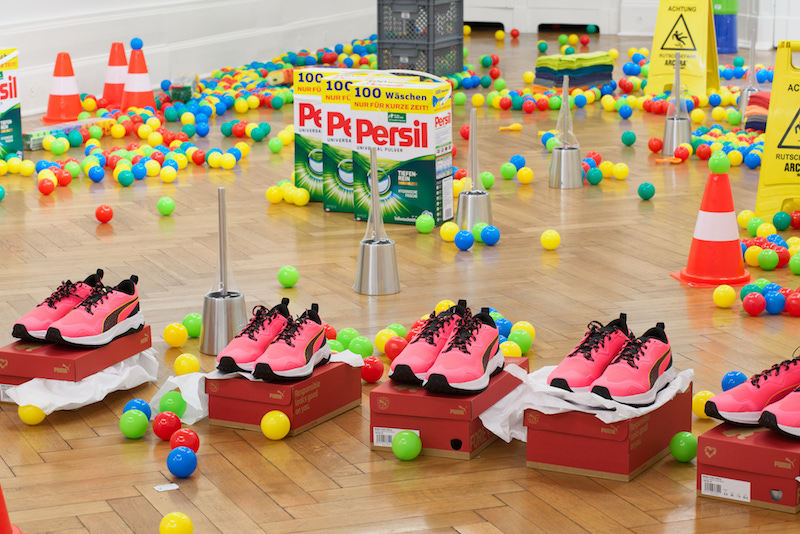
Darren Bader: ‘fünfdreier,’ installation view at Société, Berlin, 2023 // Photo by Joe Clark
In its exhibition iteration, the ‘Amazon.com sculpture’ was made by the gallery workers, who, in their practical purchasing decisions, proved themselves to be quite aware of the slipperiness in value that the work addresses. Among the objects artfully arranged in the gallery space were multiple boxes of Persil laundry detergent and runnings shoes of different sizes. Not least because Bader did not install or even visit the show, it is clear that the gallery staff is a collaborator in this tenuous/tentative construction of value. With the work ‘photographs I like,’ the workers even surprised the artist with their particular interpretation. As per Bader’s instructions, they chose “no less than 5 and no more than 50,000ish photographs” they “liked,” which happened to be publicly available photographs of the artist himself. The resulting obsessive collage of the artist’s face apparently made Bader wonder aloud if he shouldn’t have added a caveat to his instructions.
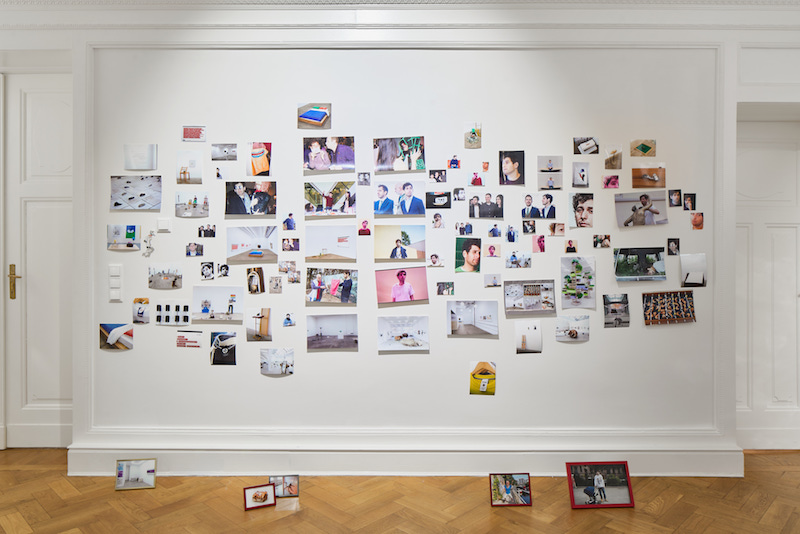
Darren Bader: ‘fünfdreier,’ installation view at Société, Berlin, 2023 // Photo by Joe Clark
Just as Bader’s work initiates a new circulation of things for the sake of art, it also initiates a circulation of meaning, some of which is likely no more than a nod and a wink. For example, even the gallery’s owner appears as a character in the artist’s press release, which claims the show materialised as a result of his unflagging “enthusiasm.” The shared ethos binding the artist and his dealer might be additionally intuited from the gallery’s name. Aptly situated around the corner from Berlin’s luxury shopping mile, Société was christened such by Daniel Wichelhaus because he “wanted something that said ‘brand,’ but that almost meant nothing.” As Bader’s work repeatedly shows, something similar could be said about the word art, or, for that matter, money.
Could the edge of nihilism in Bader’s work and Wichelhaus’ gallery name be symptomatic of a mourning for a lack of stable meaning even if it is couched in the lightness of play and humour? For someone who questions value, Bader seems to have some defined ideas about what it should be. He has, for example, been vocally critical of contemporary curating. In his artist book ‘The Typist: 2020-2002’ he also wrote that “unresolved and meretricious shit gains outsized currency as art.”
Outsized currency happens to be a fitting term for Bader’s most explicit challenge to the notion of value. In 2015, he raised $16,000 on Indiegogo and resold it for approximately $19,000 at Christie’s. The funds then went to charity, but their curious circulation reflects the weird transactions that already take place in the world on a daily basis: old or obsolete bank notes gain value as rare artefacts, coins made of silver are worth more than the amount printed on them, banks sell debt to investors, gamers make hundreds of thousands selling virtual property, to name just a few examples. Value has long since detached itself from the object, and even from money itself, making it an abstraction based solely on the collective guesswork of speculation.
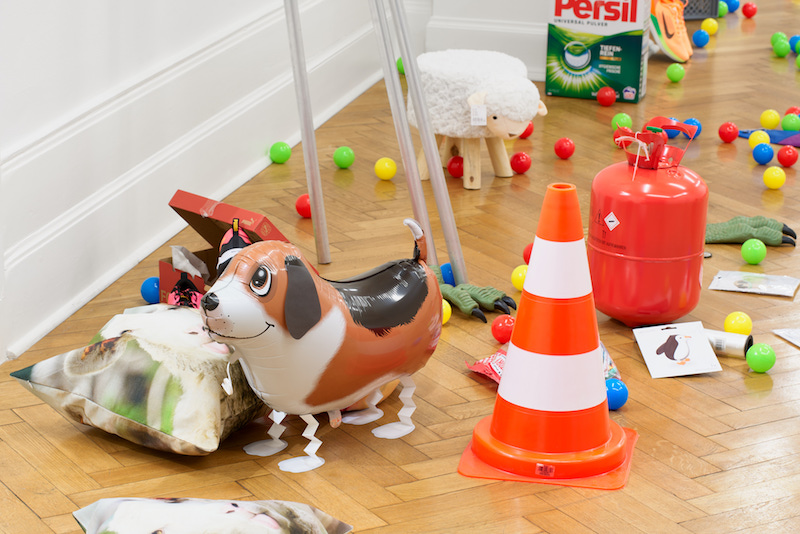
Darren Bader: ‘fünfdreier,’ installation view at Société, Berlin, 2023 // Photo by Joe Clark
What it seems to me that Bader reiterates in his work but also laments, is that meaning is not only “tenuous,” but ultimately speculative. This speculation is in turn a unique product of a given moment, which is what Bader constantly comes back to in his undated works. For the artist, time seems to be a property as relevant to an object as colour or chemical composition, pushing him into a very particular philosophical corner, namely nominalism. His musings on names in ‘The Typist’ even echo John Stuart Mill’s summary of this position—“there is nothing general except names”—which means that they might as well be superficial projections on radically separate things made after the fact. This insistence on radical uniqueness remains blind to the web of connections that allow for uniquely temporal instances—the flashes of collective will mentioned in the first paragraph. It also does not leave room to ask which values, however tenuous, might be sustained or could be sustainable. Instead, it is always focussed on their potential slippage into nothing.
It is not Bader’s job to have the answers to the question of value, nor would these answers make his work any more interesting. Nevertheless, his version of what might be termed a type of “Capitalist Realism” quickly reduces itself to a perpetual spinning of wheels. When you stare at it too long, the vertigo may overtake you and pull you into the abyss that the artist persists on staring into.
Exhibition Info
Société
Darren Bader: ‘fünfdreier’
Exhibition: Feb. 10–Apr. 8, 2023
societeberlin.com
Wielandstraße 26, 10707 Berlin, click here for map
























